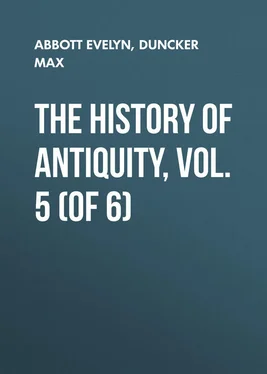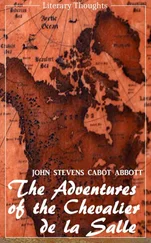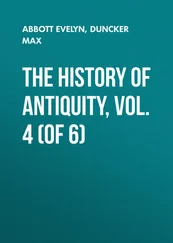Evelyn Abbott - The History of Antiquity, Vol. 5 (of 6)
Здесь есть возможность читать онлайн «Evelyn Abbott - The History of Antiquity, Vol. 5 (of 6)» — ознакомительный отрывок электронной книги совершенно бесплатно, а после прочтения отрывка купить полную версию. В некоторых случаях можно слушать аудио, скачать через торрент в формате fb2 и присутствует краткое содержание. Жанр: foreign_antique, foreign_prose, Историческая проза, на английском языке. Описание произведения, (предисловие) а так же отзывы посетителей доступны на портале библиотеки ЛибКат.
- Название:The History of Antiquity, Vol. 5 (of 6)
- Автор:
- Жанр:
- Год:неизвестен
- ISBN:нет данных
- Рейтинг книги:4 / 5. Голосов: 1
-
Избранное:Добавить в избранное
- Отзывы:
-
Ваша оценка:
- 80
- 1
- 2
- 3
- 4
- 5
The History of Antiquity, Vol. 5 (of 6): краткое содержание, описание и аннотация
Предлагаем к чтению аннотацию, описание, краткое содержание или предисловие (зависит от того, что написал сам автор книги «The History of Antiquity, Vol. 5 (of 6)»). Если вы не нашли необходимую информацию о книге — напишите в комментариях, мы постараемся отыскать её.
The History of Antiquity, Vol. 5 (of 6) — читать онлайн ознакомительный отрывок
Ниже представлен текст книги, разбитый по страницам. Система сохранения места последней прочитанной страницы, позволяет с удобством читать онлайн бесплатно книгу «The History of Antiquity, Vol. 5 (of 6)», без необходимости каждый раз заново искать на чём Вы остановились. Поставьте закладку, и сможете в любой момент перейти на страницу, на которой закончили чтение.
Интервал:
Закладка:
Max Duncker
The History of Antiquity, Vol. 5 (of 6)
BOOK VII.
THE ARIANS OF EASTERN IRAN
CHAPTER I.
THE LAND AND THE TRIBES
Between the valley of the Indus and the land of the Euphrates and Tigris, bounded on the south by the ocean and the Persian Gulf, on the north by the broad steppes which the Oxus and Jaxartes vainly attempt to fertilise, by the Caspian Sea and the valley of the Aras, lies the table-land of Iran. Rising to an average height of 4000 feet above the level of the sea, it forms an oblong, the length of which from east to west is something more than 1500 miles. The breadth in the east is about 1000 miles, but at the narrowest point, from the Caspian Sea to the Persian Gulf, it is not much more than 500 miles; while the western edge, reaching from the Persian Gulf to the mountains of Aderbeijan, again extends over a distance of about 750 miles.
In this seclusion, neither penetrated by bays of the sea nor traversed by mighty rivers, the region exhibits a certain similarity to the highlands of Arabia. The centre of the Iranian land, like that of Arabia, is occupied by a great desert where only nomadic life is possible. But the soil of Iran is more diversified in regard to elevation and depression. The northern half of the land is higher than the southern, the centre is hollowed out in the form of a trough, so that in the east, at any rate, the waters from the inner slopes of the mountainous rim fall into the depression, and collect in fructifying lakes. The oases and fertile valleys are more numerous and extensive than in Arabia, and though the rivers of the inner table-land, like the streams of the northern edge, which flow to the north, are lost in the sand or end in unimportant lakes, they nevertheless render agriculture possible over wide tracts of country.
The northern side is more diversified and superior in formation to the south. The southern edge, which sinks down to the ocean, closely resembles Arabia in the climate and the nature of the country; the mountains of the north, on the other hand, exhibit green pastures and splendid forests where Arabia has nothing but bare peaks: in the Hindu Kush, and Elburz on the Caspian Sea, as well as in Aderbeijan, they rise into vast Alpine districts. The eastern edge, extending over a distance of 900 miles, rises like a steep wall out of the valley of the Indus; a few long and difficult passes lead from the Indus to the high ground, which on the north commences with cold bare flats, and on the south with slopes still more desolate and barren, and at the same time intolerably hot. Only the terraces of the valley of the Cabul, which flows down into the Indus, allow a convenient exit towards the north, and present a soil to a great extent so fertile that three harvests can be reaped in the year. The western edge of Iran, on the other hand, is formed by parallel ridges running from the north-west to the south-east, between which, beside extensive mountain pastures, lie narrow and well-watered valleys. In the north-west the low-lying regions are rich in meadows and forest; while those between the abutting ridges of the western and southern edge are warm, and even hot, in climate, rich and luxuriant in vegetation.
On this table-land the heat is softened, though not entirely, by the elevation of the soil. After violent storms in the spring, no cloud darkens the sky from May to September; the atmosphere is peculiarly dry and clear, and through the fine air can be seen, bright and sharp, the outlines of the mountains and the whole country, while at night the star-lit sky almost replaces the light of day. The changes in temperature are sudden and severe. From cold, snow-covered terraces, 8000 feet in height, we suddenly descend to the glowing heat of the plains, lying barely 2000 feet above the sea. In the north-east oppressive heat alternates with great cold; the north suffers from a severe winter, with heavy falls of snow and icy storms, blowing over the Caspian Sea and the broad steppes; in the south the air is filled with the dust of the desert, here extraordinarily fine, and the hot winds give the heaps of sand the appearance of changing waves, and roll masses of it to the sky. 1 1 Ritter, "Erdkunde," 7, 234-240; 8, 721.
As far back as our information extends, we find the table-land of Iran occupied by a group of nations closely related to each other, and speaking dialects of the same language. On the edges of that great desert, which occupies the centre of the land, are tracts of pasture, and further inland, treeless steppes, which, however, are watered here and there by brackish pools, and produce a salt vegetation barely sufficient to provide buffaloes and camels with sustenance, until the soil becomes entirely barren. In the western part of these steppes wandered a pastoral people, whom Herodotus calls Sagartians. They were horsemen, but, according to the historian's statement, carried no weapons of attack beyond a dagger and a rope of twisted straps, at one end of which was a loop. In this they placed their confidence in battle; they threw it over men and horses, and so dragged them down and strangled them. In the inscriptions of the Achæmenids this nation is called Açagarta . 2 2 Herod. 1, 125; 7, 85; Lassen, "Z. D. M. G." 6, 55. Herodotus reckons the Paretaceni among the tribes of the Medes (1, 101); the Sagartians, whom he represents as armed partly like Persians, partly like Pactyans, with the Carmanians, he places among the Persians. Yet the nomad Sagartians seem rather to have had relations with the Medes than the Persians; for, according to the inscription of Behistun, a rebel obtains a following among the Sagartians by giving himself out to be a descendant of Cyaxares, the Median king. Ptolemy places the Sagartians in Media; cf. Plin. "Hist. Nat." 6, 29.
Close to the Indus, and beyond the bare, hot, treeless shores of the ocean, the southern part of the plain consists of sandy flats, in which nothing grows but prickly herbs and a few palms. The springs are a day's journey from each other, and often more. This region was possessed by a people whom Herodotus calls Sattagydæ, and the companions of Alexander of Macedonia, Gedrosians. 3 3 Arrian, "Anab." 6, 22 ff.; "Ind." 25, 26; Curtius, 9, 10, 5.
Among the nations of the East who were subject to them, the inscriptions of the Achæmenids mention the " Thataghus ," which the Greeks understood as Sattagush and Gadrush. Neighbours of the Gandarians, who, as we know, dwelt on the right bank of the Indus down to the Cabul, the Gedrosians led a wandering, predatory life; under the Persian kings they were united into one satrapy with the Gandarians. 4 4 Behistun, 1, 6; Persep. 1, 17; Herod. 3, 91.
To the south of the Gedrosians, on the coast, there dwelt, according to the Greeks, a miserable race, eaters of fish and tortoises, who built their houses of the bones of whales thrown up by the sea. They wove their nets from the bark of palms, and their weapons were javelins hardened in the fire. 5 5 Strabo, p. 711; Arrian, "Ind." 25, 26; "Anab." 6, 23.
The edge on the south allows no streams of any size to flow to the sea, so that even to this day this coast presents only a few small fertile spots. About equally distant from the northern and southern edge of the table-land, to the east of the desert of the interior, lies a considerable lake, now called Hamun, but known to the Greeks as Areios. It forms the centre of a cultivated district, though the storms from the west often drive the sand of the desert to its shores. This basin is formed by and receives important streams flowing from the inner slopes of the northern and eastern edge. From the southern spurs of the Hindu Kush comes the Hilmend, the Haetumat of the Avesta,
Интервал:
Закладка:
Похожие книги на «The History of Antiquity, Vol. 5 (of 6)»
Представляем Вашему вниманию похожие книги на «The History of Antiquity, Vol. 5 (of 6)» списком для выбора. Мы отобрали схожую по названию и смыслу литературу в надежде предоставить читателям больше вариантов отыскать новые, интересные, ещё непрочитанные произведения.
Обсуждение, отзывы о книге «The History of Antiquity, Vol. 5 (of 6)» и просто собственные мнения читателей. Оставьте ваши комментарии, напишите, что Вы думаете о произведении, его смысле или главных героях. Укажите что конкретно понравилось, а что нет, и почему Вы так считаете.












